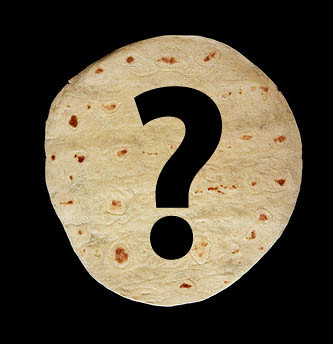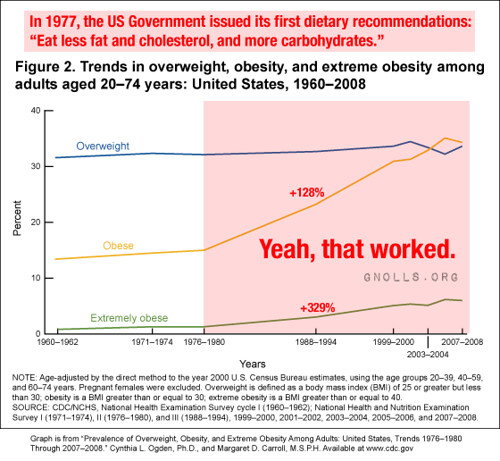(This article is Part III of a series on carbohydrate addiction. Each part stands alone, but I recommend starting with Part I, “Why You’re Addicted To Bread“, as it explains the fundamentals. Part II is here.)
The Mystery of the Flour Tortilla
This article started when I asked a simple question: “Why do flour tortillas have such a low glycemic index?”
The humble flour tortilla tops any list of low glycemic index grain products, with a GI of only 30. Yet whole-wheat bread has a GI of 71! (Source.)
Why is that?
“Complex Carbohydrates”…Not So Complex After All
Most low-fat diet pushers (from Pritikin, to Ornish, to the ADA and US government, to vegan fronts like the PCRM) make a big noise about “complex carbohydrates”. The theory goes like this: Table sugar is made of just two simple sugars, glucose and fructose. That’s bad, because it digests too quickly for our body to use all of it—whereupon the excess is turned into fat, stored as fat, and we’re hungry again. In contrast, the ‘complex carbohydrates’ in whole-grain products are good because they digest more slowly, allowing our body to use all of them. Right?
Wrong.
As described in Part I, whole wheat bread (71) has the same glycemic index as white bread (72), and both of them have a higher GI than white table sugar (62)! This fact alone proves that the theory of “complex carbs” is flawed: our bodies absorb the sugar from that ‘healthy’ whole wheat bread more quickly than…pure table sugar.
Low Glycemic Index: What’s Responsible?
So what’s the real story behind glycemic index? Why do we digest some ‘carbohydrates’ (sugars) so much more slowly than others? And how does a flour tortilla top the list?
Answer: it’s the fat.
- Mexican flour tortillas have a GI of 30, whereas American whole wheat bread has a GI of 72. Remember, you need plenty of lard (or, at least, grain oil) to make a nice, flat, chewy tortilla.
- A plain French baguette has a sky-high glycemic index of 95: spread some butter and jam on it, and the GI declines to 65.
- Cooked white rice has 0.2% fat and a GI of 64; a meal of white boiled rice, grilled hamburger, cheese, and butter has a GI of 24.
- A Pizza Hut Super Supreme pizza (13.2% fat) has a GI of 30, whereas a Vegetarian Supreme (7.8% fat) has a GI of 49.
(Source.)
This is common sense once we think about it for a minute. As anyone who’s taken a freshman nutrition class can tell you, fat inhibits gastric emptying and slows digestion. For example:
Pierre Thouvenot, C Latge, M-H Laurens, and J-M Antoine. Fat and starch gastric emptying rate in humans: a reproducibility study of a double-isotopic technique. Am J Clin Nutr 1994;59(suppl):781S.
Executive Summary: A high-fat mixture of egg yolks, olive oil, and butter left the stomach over 50% slower than spaghetti…and that doesn’t even count the time taken to digest it in the intestine. (Also note that spaghetti has a glycemic index of 38-61, depending on cooking time—much lower than bread or cereal at 70-80.)
In conclusion, the theory of “complex carbs” is a red herring. The primary driver of glycemic index is fat content. The more fat, the slower the sugars (‘carbohydrates’) are digested, and the lower the glycemic index.
(Yes, it is possible to make lower-GI pure carbohydrates: a wheat ‘bread’ containing 80% intact kernels gets down to a GI of 52…just under a Snickers bar at 55. But wait…80% intact kernels? That’s not bread…that’s a cake of birdseed! I’ve never even seen that sold in a store, let alone watched someone actually try to eat it.)
Conclusion: A Low-Fat Diet Means A High Glycemic Index Diet
When we take fat out of our diet and replace it with ‘carbohydrates’ (sugars), the glycemic index of the food we eat goes up dramatically.
This has obvious negative consequences for our health and weight, and I’m going to highlight it, because it’s the key to this article:
High-GI ‘carbohydrates’ (sugars), simple or complex, are digested far more quickly than we can burn them for energy, whereupon our bodies convert them into fat and store them as fat—leaving us hungry, even though we are gaining weight!
Then, we get a transient dopamine rush and subsequent serotonin high before our blood sugar crashes, but that decreases over time as we get fatter—meaning that we are chemically as well as metabolically addicted to sugar (‘carbohydrates’).
Does this situation sound familiar? You’re told to take those ‘unhealthy’ fatty foods out of your diet—and suddenly you’re either hungry and miserable, or you’re gaining weight uncontrollably. Ever wonder why you don’t feel full no matter how many plain bagels, glasses of skim milk, cups of low-fat yogurt, and boxes of fat-free Fig Newtons you eat…yet you still have the compulsion to keep eating?
Even worse, if this vicious cycle of goes on long enough, you become insulin-resistant, and then diabetic. Isn’t this what’s happening to all of America? Our ‘obesity epidemic’ started once we told people to avoid fat at all costs…
…and now you know why. It’s because by removing fat from your diet, you’re turning everything you eat into candy.
Incredible but true fact: a medium Jamba Juice fruit smoothie (‘Berry Lime Sublime’) has substantially more calories (487) than a Quarter Pounder (417)—and a large has almost as many calories (610) as a Double Quarter Pounder (647)!
Which one will leave you feeling like you ate a meal, and which one will leave you still hungry?

...than the Quarter Pounder!

This has more calories...
But Isn’t Fat Bad For You? Science Says “No.”
We’ve been told for decades that fat and cholesterol are bad, and saturated fat will kill you. That is, stated baldly, a lie.
There is no association between saturated fat intake and heart disease, and there is no association between egg intake (the largest source of dietary cholesterol) and heart disease.
Patty W Siri-Tarino, Qi Sun, Frank B Hu, and Ronald M Krauss. Meta-analysis of prospective cohort studies evaluating the association of saturated fat with cardiovascular disease. Am J Clin Nutr Jan 2010
“A meta-analysis of prospective epidemiologic studies showed that there is no significant evidence for concluding that dietary saturated fat is associated with an increased risk of CHD or CVD.”
[…]
“The pooled relative risk estimates that compared extreme quantiles of saturated fat intake were 1.07 (95% CI: 0.96, 1.19; P = 0.22) for CHD, 0.81 (95% CI: 0.62, 1.05; P = 0.11) for stroke, and 1.00 (95% CI: 0.89, 1.11; P = 0.95) for CVD. Consideration of age, sex, and study quality did not change the results. “
Here’s the layman’s version, from Scientific American:
“Carbs Against Cardio: More Evidence that Refined Carbohydrates, not Fats, Threaten the Heart“, Scientific American, May 2010
“…The quintile of women who ate the most easily digestible and readily absorbed carbohydrates—that is, those with the highest glycemic index—were 47 percent more likely to acquire type 2 diabetes than those in the quintile with the lowest average glycemic-index score.” … “women who were overweight and in the quartile that consumed meals with the highest average glycemic load, a metric that incorporates portion size, were 79 percent more likely to develop coronary vascular disease than overweight women in the lowest quartile.”
“The next time you eat a piece of buttered toast, [Ludwig] says, consider that ‘butter is actually the more healthful component.'”
Moving on to eggs:
Public Health Nutr. 2010 Jul 16:1-10. Egg consumption and CHD and stroke mortality: a prospective study of US adults. Scrafford CG, Tran NL, Barraj LM, Mink PJ.
“We did not find a significant positive association between egg consumption and increased risk of mortality from CHD or stroke in the US population. These results corroborate the findings of previous studies.”
So: eat fatty meats, eat eggs, eat avocados. Cook with butter, tallow, and coconut oil, and perhaps some extra-virgin olive oil for taste. And if you absolutely must eat candy in the form of bread, cereal, or potatoes, eat them with plenty of butter, olive oil, cream, and whole milk.
Sounds a lot better than rice cakes and dry toast, doesn’t it?
Live in freedom, live in beauty.
JS
Postscript: if you want to know how we got bamboozled into believing that foods we’ve eaten for millions of years (meat) were bad for us, but industrial products that didn’t even exist until this century (‘vegetable oil‘) were good for us, you can watch Tom Naughton’s entertaining presentation “Big Fat Fiasco”, available here and on DVD here.
(This is Part III. Go back to Part I, Part II.)
“So what do YOU eat?” you ask. Click here for my classic article “Eat Like A Predator”.
My most recent articles are listed on the left sidebar. Or, click here for an index, organized by topic.
May I suggest subscribing to my RSS feed, or to my newsletter (right sidebar: scroll up)? I update on Tuesdays, sometimes more often.
Did you enjoy this series? Use the buttons below to share it with your friends! And if you want to support gnolls.org, buy my “Funny, provocative, entertaining, fun, insightful” book, The Gnoll Credo. (Read more glowing reviews here, and the first 20 pages here. Outside the USA? Try here.)





